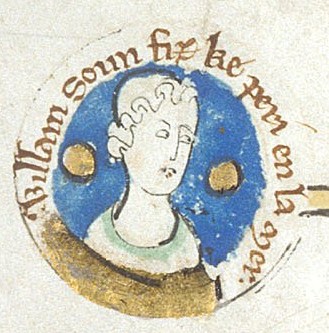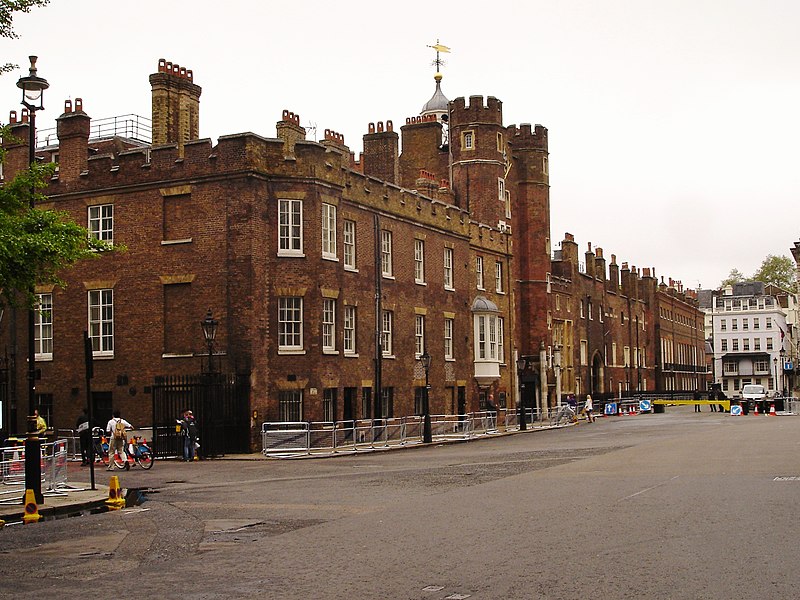by Susan Flantzer
© Unofficial Royalty 2022

Westminster Hall from Rudolph Ackermann’s Microcosm of London, November 1801; Credit – Wikipedia
On the River Thames in London sits the Palace of Westminster, commonly known as the Houses of Parliament, the meeting place of the House of Commons and the House of Lords, the two houses of the Parliament of the United Kingdom. The building we see today was built after a fire destroyed the medieval Palace of Westminster in 1834. The first royal palace was built on the site in the 11th century and was the primary residence of the Kings of England until a fire destroyed much of the palace in 1512. After that, it served as the home of Parliament. Westminster Hall, built in 1097, survived both fires. It was saved from the fire of 1834 because of the actions of the floating fire engine on the River Thames and also because a change in the wind direction kept the flames away.

Palace of Westminster; Credit – By Terry Ott from Washington, DC Metro Area, United States of America CC BY 2.0, https://commons.wikimedia.org/w/index.php?curid=122737498
This writer has visited Westminster Hall and can attest that it is an impressive structure even today. It was built during the reign of King William II Rufus, the son of King William I the Conqueror. At the time it was built in 1097, it was the largest hall in Europe. It measures 240 by 67 feet (73 by 20 meters) and has an area of 16,080 square feet (1,460 square meters). Originally the roof was flat, but during the reign of King Richard II, the flat roof was replaced by a spectacular hammerbeam roof created by the royal carpenter Hugh Herland. The hammerbeam roof has been called the greatest creation of medieval timber architecture.
Major Events that took place in Westminster Hall
Lying-In-State
Although Westminster Hall has existed for more than 900 years, it only became the site for lyings-in-state towards the end of the nineteenth century. The first lying-in-state to be held there was for Prime Minister William Ewart Gladstone in 1898. It is thought that the lying-in-state was held in Westminster Hall rather than a religious building because of Gladstone’s long association with the Palace of Westminster, where he served as a Member of Parliament for sixty-four years. Queen Victoria did not want a lying-in-state and so her son and heir King Edward VII was the first monarch to have a lying-in-state at Westminster Hall.
Lying-in-state of William Ewart Gladstone
1898 – William Ewart Gladstone – served as Prime Minister of the United Kingdom four times during the reign of Queen Victoria: 1868 – 1874, 1880 – 1885, February 1886 – July 1886, and 1892 – 1894.
*********************

Lying-in-state of King Edward VII; Credit – Wikipedia
1910 – King Edward VII
*********************
1914 – Field Marshal Frederick Sleigh Roberts, 1st Earl Roberts – British Victorian era general who became one of the most successful British military commanders of his time.
*********************
Lying-in-state of King George V
1936 – King George V
*********************
Lying-in-state of King George VI
1952 – King George VI
*********************
Lying-in-state of Queen Mary
1953 – Queen Mary, wife of King George V
*********************
Lying-in-state of Sir Winston Churchill
1965 – Sir Winston Churchill – Prime Minister of the United Kingdom 1940 – 1945, during the Second World War, and 1951 – 1955
*********************
Lying-in-state of Queen Elizabeth The Queen Mother with her four grandsons standing guard
2002 – Queen Elizabeth the Queen Mother, wife of King George VI
*********************
Lying-in-state of Queen Elizabeth II
2022 – Queen Elizabeth II
Coronation Banquets

Coronation banquet of King George IV; Credit – Wikipedia
From 1189 to 1821, Westminster Hall was the traditional venue for coronation banquets honoring newly-crowned monarchs. The earliest recorded coronation banquets at Westminster Hall were those of two sons of King Henry II:
1170 – Henry the Young King – King Henry II decided to adopt the French practice of ensuring the succession by declaring his heir the junior king and having him crowned at Westminster Abbey in 1170. His son, called Henry the Young King, was not the actual monarch, but he still had a coronation banquet at Westminster Hall. Henry the Young King never became King of England because he predeceased his father dying in 1183 at the age of twenty-eight.
1189 – King Richard II, known as the Lionheart, became the heir of his father King Henry II after the death of his elder brother Henry the Young King. He succeeded his father in 1189.
Coronation banquets continued through the reign of King George IV who had the last coronation banquet in 1821. His brother and his successor King William IV, eliminated coronation banquets because he thought they were too expensive.
Queen Consorts crowned separately from their husbands also had coronation banquets, from Eleanor of Provence, the wife of King Henry III in 1236, to Anne Boleyn, the second of the six wives of King Henry VIII in 1533.
Famous State Trials
Westminster Hall was often used for judicial purposes and was the setting for some of the most famous state trials in British history.

Statue of William Wallace at Edinburgh Castle, Scotland; Credit – By Kjetil Bjørnsrud – Own work, CC BY 2.5, https://commons.wikimedia.org/w/index.php?curid=780652
1305 – State trial of William Wallace, one of the main leaders during the First War of Scottish Independence. He was hanged, drawn, and quartered for high treason.

Sir Thomas More; Credit – Wikipedia
1535 – State trial of Sir Thomas More, English lawyer, judge, social philosopher, author, statesman, King Henry VIII’s Lord High Chancellor. More opposed King Henry VIII’s separation from the Catholic Church. He refused to acknowledge King Henry VIII as Supreme Head of the Church of England and refused to recognize the annulment of Henry VIII’s marriage to Catherine of Aragon. After refusing to take the Oath of Supremacy, More was convicted of treason and executed by beheading.

Cardinal John Fisher; Credit – Wikipedia
1535 – State trial of Cardinal John Fisher – a Catholic bishop, cardinal, and theologian. Fisher was charged with treason for denying that King Henry VIII was the Supreme Head of the Church of England. He was hanged, drawn, and quartered for high treason.

A contemporary engraving of eight of the thirteen conspirators; Credit – Wikipedia
1606 – State trial of Guy Fawkes, a member of a group of English Catholics involved in the failed Gunpowder Plot to blow up the House of Lords during the State Opening of Parliament while King James I was in attendance. Fawkes and seven co-conspirators were tried for high treason and executed.

Thomas Wentworth, 1st Earl of Strafford; Credit – Wikipedia
1641 – State trial of Thomas Wentworth, 1st Earl of Strafford, a member of Parliament and a supporter of King Charles I. King Charles I, who believed in the divine right of kings, decided to govern without Parliament, beginning eleven years of personal rule. During Charles’ personal rule, Strafford was one of Charles’ most influential advisers. When Parliament was finally summoned again in 1640, the Members of Parliament demanded the execution of Stafford. King Charles I signed the death warrant, but never forgave himself.

King Charles I; Credit – Wikipedia
1649 – State Trial of King Charles I – On January 4, 1642, King Charles I committed the unprecedented act of entering the House of Commons with an armed guard and demanding the arrest of five Members of Parliament. There was a great public outcry, Charles fled London, and Civil War appeared inevitable. On August 22, 1642, at Nottingham, Charles raised the Royal Standard and called for his loyal subjects to support him, and the Civil War between the Royalists or Cavaliers (Charles’ supporters) and the Roundheads (Parliament’s supporters) had begun. On January 20, 1649, King Charles I was tried for treason and other high crimes before a tribunal of 135 judges. He refused to enter a plea because he believed no court could try a king. He was found guilty and sentenced to death. Ten days later, King Charles I was beheaded.

James Radclyffe, 3rd Earl of Derwentwater; Credit – Wikipedia
1716 – State trial of Scottish lords who took part in the 1715 Jacobite uprising who were accused of high treason: James Radclyffe, 3rd Earl of Derwentwater (beheaded); William Maxwell, 5th Earl of Nithsdale (escaped from the Tower of London the night before his execution); Robert Dalzell, 5th Earl of Carnwath (execution was first delayed, then in 1717 remitted by the Indemnity Act); William Widdrington, 4th Baron Widdrington (condemned to death but was reprieved); William Gordon, 6th Viscount of Kenmure (beheaded); and William Murray, 2nd Lord Nairne (execution was first delayed, then in 1717 remitted by the Indemnity Act)

Execution of the Earl of Kilmarnock and Lord Balmerino; Credit – Wikipedia
1746 – State trial of Scottish lords who took part in the 1745 Jacobite uprising who were accused of high treason: William Boyd, 4th Earl of Kilmarnock (executed), Arthur Elphinstone, 6th Lord Balmerino (executed)

Simon Fraser, 11th Lord Lovat; Credit – Wikipedia
1747 – State trial of Simon Fraser, 11th Lord Lovat – In 1715, Lord Lovat had been a supporter of the House of Hanover, but in 1745 he changed sides and supported the Stuart claim to the British crown. His punishment of a traitor’s death by hanging, drawing, and quartering was commuted by King George II to beheading. Lord Lovat’s execution was the last execution by beheading in Great Britain.
This article is the intellectual property of Unofficial Royalty and is NOT TO BE COPIED, EDITED, OR POSTED IN ANY FORM ON ANOTHER WEBSITE under any circumstances. It is permissible to use a link that directs to Unofficial Royalty.
Works Cited
- En.wikipedia.org. 2022. Palace of Westminster – Wikipedia. [online] Available at: <https://en.wikipedia.org/wiki/Palace_of_Westminster#Westminster_Hall> [Accessed 14 September 2022].
- UK Parliament. 2022. Westminster Hall. [online] Available at: <https://www.parliament.uk/about/living-heritage/building/palace/westminsterhall/> [Accessed 14 September 2022].

























